Louisville forecast 2019

Executive Vice Chancellor for Academic Affairs and Sanders Chair in Business, Indiana University Southeast, New Albany
Despite national GDP growth that exceeded 4 percent, Louisville metro job gains are now the slowest since 2011. A stronger national environment in manufacturing has not produced local gains in this locally important sector, and this helps explain overall slower growth for the metro area. In Southern Indiana, the jobs-producing machine of Clark County has stalled. For 2019, above-average growth is not expected, and pending uncertainty could contribute to continued slower growth regionally.
Louisville payrolls
As of this writing, the Louisville metro added approximately 5,000 payroll jobs, based on a three-month moving average, marking the lowest year-over-year performance since 2011. Through 2018, job growth has not kept pace with changes observed nationally. Except for a few months, Louisville metro year-over-year payrolls growth has consistently been under 1 percent, while national payrolls growth has hovered between 1.4 percent and 1.8 percent (see Figure 1).
Figure 1: Year-over-year percent change in payroll jobs, January 2000 to September 2018
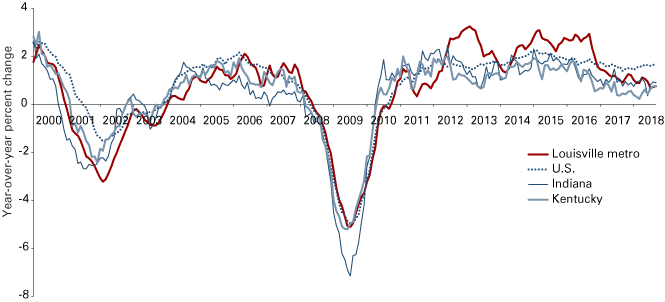
Source: Factset
Sector growth
Dissecting payroll growth by sector allows one to develop a better understanding of this slower growth. Back in 2011, manufacturing growth exceeded overall job growth for the entire year. Louisville metro payroll growth was weaker as the country continued to recover from the hard recession that ended in 2009. The 2011 growth in manufacturing was on the eve of double-digit growth the following year, and the subsequent stronger growth for the metro area. The present decline in manufacturing began in early 2017. For almost all of 2018, manufacturing has been shedding jobs.
Another large sector, education and health services, is also in negative territory for 2018. Seeing robust growth in 2017, education and health services peaked in the middle of 2017 and has been declining since, with actual job declines since early 2018. Transportation and utilities (transportation being a key cluster for the Louisville region) showed relatively moderate growth over 2018, with the most recent growth lower than overall payroll growth.
Job growth in professional and business services, retail, and leisure and hospitality is exceeding the rate of overall growth in 2018 (see Figure 2). For the most recent data available, growth in both professional and business services and retail is approximately 5 percent, contributing to overall growth. Other sectors, including mining, logging, construction, wholesale trade, government, information and financial activities are showing either negative or growth less than overall payroll growth.
Figure 2: Year-over-year percent change in payroll jobs for selected Louisville metro sectors, September 2016 to September 2018
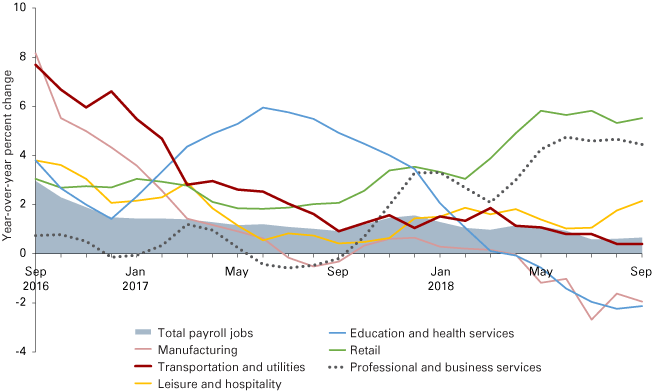
Source: Factset
Southern Indiana
Since the recession, the growth engine for Southern Indiana has been Clark County. A significant portion of Southern Indiana job growth occurred in Clark County, with much of this growth attributed to the mega commercial site of River Ridge. For example, the fourth quarter of 2015 registered a net positive 4,055 increase in payrolls compared to the prior year—possibly the largest payroll gain in Clark County history. That impressive job growth has come to a complete standstill. In the last quarter alone, Clark County lost 832 jobs from the prior year. In fact, the last five quarters of data available show that Clark County has been a net loser of payrolls year over year.
Clark County payroll losses cannot be attributed to any one industry. Retail is the cause of the decline during the last quarter of data availability, but transportation and warehousing and administrative and support services have also contributed to losses. During the last quarter of data availability, Southern Indiana, minus Clark County, added over 1,000 jobs. Thus, the slower growth in Southern Indiana is simply the result of the jobs decline in Clark County (see Figure 3).
Figure 3: Change in Southern Indiana and Clark County payroll jobs, 2008 Q1 to 2018 Q1
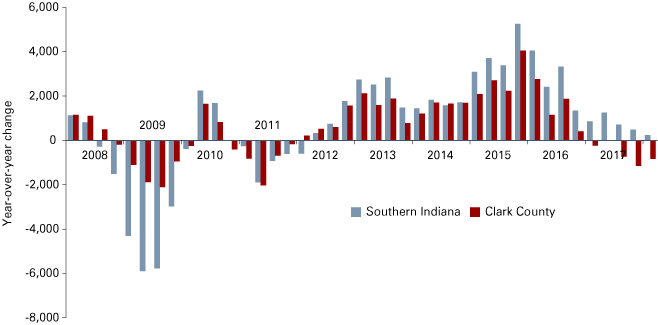
Source: STATS Indiana, using Quarterly Census of Employment and Wages data from the U.S. Bureau of Labor Statistics
A divergence
At a time when the nation’s economy is growing jobs at a rate that hovers around 1.5 percent, the Louisville metro has not been able to move past 1 percent. Insight into this divergence between the national economy and the region can be seen by comparing Louisville payrolls growth and national gross domestic product (GDP). As evident from Figure 4, there has been a divergence between national GDP and Louisville job growth since the Great Recession. A divergence over several quarters is not uncommon, but this trend has been more pronounced in the last couple of years. As year-over-year GDP has increased, we have yet to observe the corresponding job gains locally.
Figure 4: Comparing change in national GDP and Louisville metro payrolls
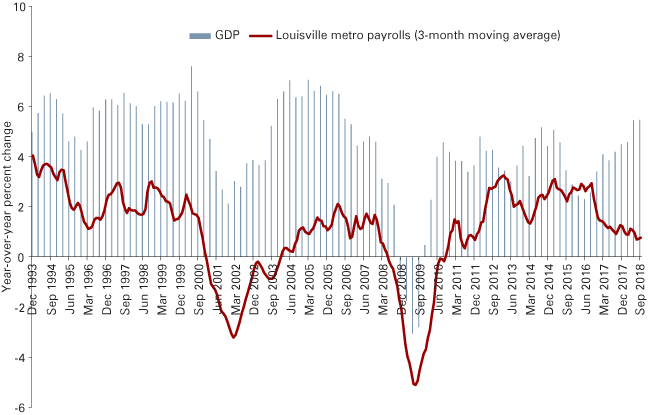
Source: Factset
Labor force issues
A possible explanation for slowing job growth is the availability of workers (see Figure 5). From 2013 to 2016, for example, the change in the regional labor force was basically flat. Since 2016, the metro area began seeing steady growth in its labor force, but has recorded weaker numbers in recent months. We are observing a levelling of labor force and employment growth in the current year, and this could be a possible explanation for current year growth.
Figure 5: Louisville metro labor force and employment, January 2009 to August 2018
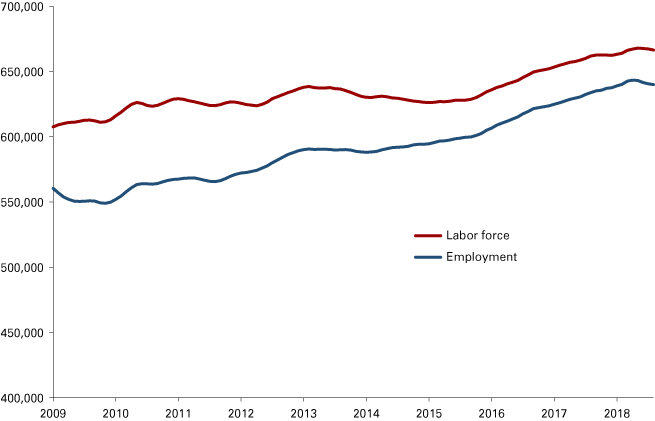
Source: Factset
Summary and general outlook
Despite a strong national economy, the Louisville metro has not produced job growth consistent with payroll gains nationally. Last year was the weakest since 2011. Last year’s outlook expressed concern about the region’s ability to grow jobs due to challenges associated with labor force growth.1 We have seen this materialize as evident by the overall weaker job growth. The question now is whether this will continue for 2019. Slower growth will be observed nationally, and this will produce headwinds for economic growth locally. Expect continued moderation in the regional economy, with job growth continuing to lag the nation’s rate. We will see challenges associated with national economic growth, potentially led by weaker consumer spending and business investment—the result of political and financial uncertainty.
Notes
- Uric Dufrene, “Louisville Forecast 2018,” Indiana Business Review, Winter 2017, www.ibrc.indiana.edu/ibr/2017/outlook/louisville.html.



